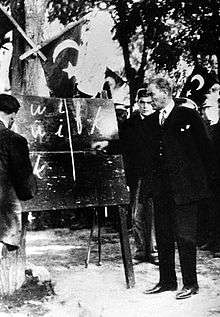Nation's schools
Nation’s school (Turkish: Millet mektebi) was the name of a campaign of series of courses offered to adults to learn the Latin alphabet in Turkey in 1929-1932 term.
Background
The alphabet of the Ottoman Empire (just like the many other Islamic countries) was the Arabic alphabet. This alphabet was incapable of reproducing some vowels in Turkish. But being the script of Quran it was considered to be inalterable. But in 1928, Atatürk the founder of the Turkish Republic decided to adopt Latin alphabet. The Turkish alphabet (actually altered Latin alphabet) has 29 letters. There are no Q, W,and X. The other 23 letters are identical to those in the Latin alphabet. There are also umlaut versions of O, U and I as well as Ç, Ş and Ğ.
Alphabet reform
In June 1928 Atatürk asked Mustafa Necati, the minister of National Education to form a committee to adopt the Latin alphabet. On 9 August 1928, Atatürk announced that the Latin alphabet would replace the Arabic alphabet. On 1 Navember 1928 the parliament (3rd Parliament of Turkey) passed the law of the new Turkish alphabet (act no 1353) and on 11 November 1928 the government (5th government of Turkey) decided to establish the nation’s schools. The project began on 24 November 1928. These schools were actually series of short courses for the adults . According to Falih Rıfkı Atay, a member of the committee, the learning the Latin alphabet was more difficult for the literate people who already used to Arabic alphabet than the illiterate people [1] He adds that if the rate of literacy was not so low, the alphabet reform would be impossible.
First day of the campaign


The first example of the Nation’s school was in Dolmabahçe Palace. Beginning by 1 January 1929 many schools were opened all over Turkey. Mustafa Necati, who was responsible for these schools died on the very same day the schools opened due to appendicitis. He is now considered as one of the pioneers of the Turkish alphabet.
School regulations
According to regulations these schools were compulsory for everybody between 14–45 years of age. The women were offered two courses per week and men were offered four courses a week. The duration was 2–4 months depending on the prior education of the students.[2] The courses were also offered to prisoners . In 1930s most villages had no schools. For these villages mobile teaching teams were formed. All students were expected to pass a final exam to obtain a certificate. The top scoring student of each school received a signed photo of Atatürk and a book of constitution.[3]
Atatürk who earned the title başöğretmen ("head teacher") actively participated in the Nation’s school program and in his travels he taught the new alphabet.
Conclusion
In the first year the number of schools (actually classrooms) was 20,487 and the number of students was 1,075,500. 485,632 men and 111,378 women received certificates.[4] At the end of the term in 1930s the total number of the graduates was 1,217,144.[3]
Commemoration
Beginning by 1981 each year 24 November (start of the project) is commemorated as "Teachers' day" in Turkey .
See also
References
- ↑ Refik Halit Karay:Çankaya,ISBN 975-6461-05-5 p 482
- ↑ Online encyclopaedia (Turkish)
- 1 2 Serenti page (Turkish)
- ↑ Turkish reform page (Turkish)